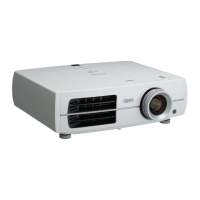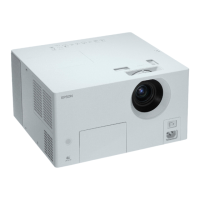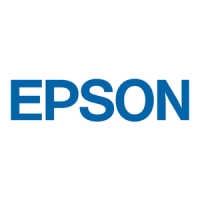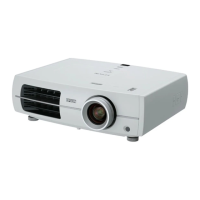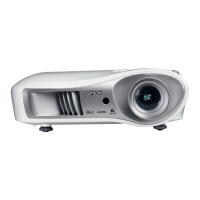Do you have a question about the Epson DREAMIO EH-TW2900 and is the answer not in the manual?
Introduces the two types of manuals provided with the projector.
Explains symbols for safety indications and general information.
Clarifies the terms 'unit' and 'projector' as used in the guide.
Lists all items included in the projector package for verification.
Explains how to select color modes to match projection environments.
Details how the 'x.v.Color' mode enhances natural color reproduction.
Describes sophisticated options for adjusting color temperature and RGB/RGBCMY components.
Explains the wide-angle lens shift for image positioning flexibility.
Highlights the 2.1x short throw zoom lens for flexible projection distances.
Covers advanced functions like Auto Iris and Sharpness for enhanced image quality.
Lists other useful functions like EPSON Super White and Lock settings.
Identifies and explains the function of parts on the front and top of the projector.
Details the buttons and indicators on the projector's top and side control panels.
Explains the purpose and operation of each button on the remote control.
Identifies all input/output ports on the rear of the projector.
Describes the base, including suspension bracket points and cable cover stays.
Provides detailed diagrams and dimensions of the projector's exterior.
Guides on positioning the projector for optimal screen size using distance tables.
Explains the use of lens shift dials for image positioning without distortion.
Details methods for projecting from front, side, or ceiling.
Illustrates how to connect various video equipment and computers to the projector.
Instructions for inserting batteries into the remote control correctly.
Defines the horizontal and vertical operating range for the remote control.
Step-by-step guide to turning on the projector and connected equipment.
Steps to take when expected images are not projected.
Procedure for safely turning off the projector, including cool-down.
How to adjust focus and projection size using the zoom ring.
Detailed guide on using lens shift for vertical and horizontal image placement.
Using front feet to adjust the projector's tilt for a level image.
How to use the built-in test pattern for setup without external equipment.
Guide to choosing preset color modes for different environments.
How to select the aspect ratio for optimal viewing of different input signals.
Adjusting tone, vividness, and brightness for color components.
Explains gamma adjustment for image brightness and contrast.
Fine-tuning R, G, B color components for hue, saturation, and brightness.
Adjusting gamma visually or via a graph for specific image needs.
Adjusting dark (offset) and bright (gain) areas for R, G, B components.
Fine-tuning image sharpness using various enhancement options.
Configuring the automatic aperture for optimal light intensity and contrast.
How to save current image adjustments to memory slots.
Retrieving previously saved image settings for quick application.
Procedures for deleting unwanted memories and renaming them for clarity.
Presents all adjustable items within the projector's configuration menus.
Explains the line menu for real-time adjustment effect viewing.
Step-by-step guide on displaying menus and modifying settings.
Lists and explains all items within the projector's Image menu.
Lists and explains all items within the projector's Signal menu.
Lists and explains all adjustable functions in the Settings menu.
Describes the Info menu for displaying projector status and error information.
Detailed explanation of Color Mode and Brightness settings.
Explains settings for Contrast, Color Saturation, and Tint adjustments.
Covers Sharpness adjustment and Absolute Color Temperature settings.
Details Skin Tone adjustments and the Advanced menu options.
Fine-tuning hue, saturation, and brightness for RGBCMY components.
Explains automatic contrast enhancement and image detail improvement.
Options for setting lamp brightness to optimize power usage.
How to configure Auto Iris and reset Image menu settings to defaults.
Adjusting aspect mode and zoom for optimal image display.
Setting image position and configuring progressive scan modes.
Controls for motion detection and frame interpolation for smoother video.
Settings for 2-2/4-4 pull-down and automatic input signal adjustment.
Reducing image noise and adjusting black level for compatibility.
Enabling Super White and adjusting display area with Overscan.
Configuring Direct Power On, Sleep Mode, Child Lock, and Panel Lock.
Adjusting projection method, illumination, and menu display properties.
Setting video signal format and component signal type for input sources.
Selecting display language and resetting Settings menu items.
Managing saved image quality settings via memory functions.
Customizing memory names for easier identification of saved settings.
Restoring all configuration menus to their default values.
Resetting saved memories and the lamp operating time counter.
Explains projector status indicators and their meanings.
Describes indicator states during standby, warm-up, projection, and cool-down.
Addresses issues when indicators don't identify the problem clearly.
Steps to resolve issues where no image is projected or the screen is black/blue.
Solutions for when moving images from computers are not displayed.
How to resolve the 'Not Supported' message by checking signal formats.
Steps to fix the 'No Signal' message by checking cables and input ports.
Diagnosing and fixing issues with image focus and lens condensation.
Solutions for interference, distortion, or incorrect signal format.
Adjusting aspect ratio and position for image truncation issues.
How to correct image colors, contrast, and tint settings.
Addressing dark images due to brightness, contrast, or lamp replacement needs.
Resolving issues where projection stops due to sleep mode or overheating.
Steps to troubleshoot a non-functional remote control.
Instructions for cleaning the projector's air filter to prevent overheating.
Guide on how to clean the projector's exterior surfaces.
Proper methods for cleaning the projector lens without damage.
When to replace the air filter, including warning messages.
Indicates when the lamp needs replacement based on usage hours.
Step-by-step guide for removing and installing a new air filter.
Detailed instructions for safely replacing the projector lamp.
Procedure to reset the lamp operating time after replacement.
Lists optional accessories like portable screens and mounting hardware.
Lists available consumables such as lamp units and air filters.
Table showing supported resolutions and aspect modes for Component Video.
Table detailing supported resolutions for Composite Video and S-Video.
Lists resolutions and modes supported for computer inputs.
Table of resolutions and modes supported via HDMI input.
Key technical specifications including dimensions, resolution, and power.
Information on projector tilt limits and RS-232C connectivity.
Statement regarding FCC rules for Class B digital devices and potential interference.
Explains terms like Aspect, Component Video, Composite Video, and Contrast.
Defines terms related to signal synchronization, tracking, and VGA.
Provides an index of terms, features, and page numbers for quick reference.
Introduces the two types of manuals provided with the projector.
Explains symbols for safety indications and general information.
Clarifies the terms 'unit' and 'projector' as used in the guide.
Lists all items included in the projector package for verification.
Explains how to select color modes to match projection environments.
Details how the 'x.v.Color' mode enhances natural color reproduction.
Describes sophisticated options for adjusting color temperature and RGB/RGBCMY components.
Explains the wide-angle lens shift for image positioning flexibility.
Highlights the 2.1x short throw zoom lens for flexible projection distances.
Covers advanced functions like Auto Iris and Sharpness for enhanced image quality.
Lists other useful functions like EPSON Super White and Lock settings.
Identifies and explains the function of parts on the front and top of the projector.
Details the buttons and indicators on the projector's top and side control panels.
Explains the purpose and operation of each button on the remote control.
Identifies all input/output ports on the rear of the projector.
Describes the base, including suspension bracket points and cable cover stays.
Provides detailed diagrams and dimensions of the projector's exterior.
Guides on positioning the projector for optimal screen size using distance tables.
Explains the use of lens shift dials for image positioning without distortion.
Details methods for projecting from front, side, or ceiling.
Illustrates how to connect various video equipment and computers to the projector.
Instructions for inserting batteries into the remote control correctly.
Defines the horizontal and vertical operating range for the remote control.
Step-by-step guide to turning on the projector and connected equipment.
Steps to take when expected images are not projected.
Procedure for safely turning off the projector, including cool-down.
How to adjust focus and projection size using the zoom ring.
Detailed guide on using lens shift for vertical and horizontal image placement.
Using front feet to adjust the projector's tilt for a level image.
How to use the built-in test pattern for setup without external equipment.
Guide to choosing preset color modes for different environments.
How to select the aspect ratio for optimal viewing of different input signals.
Adjusting tone, vividness, and brightness for color components.
Explains gamma adjustment for image brightness and contrast.
Fine-tuning R, G, B color components for hue, saturation, and brightness.
Adjusting gamma visually or via a graph for specific image needs.
Adjusting dark (offset) and bright (gain) areas for R, G, B components.
Fine-tuning image sharpness using various enhancement options.
Configuring the automatic aperture for optimal light intensity and contrast.
How to save current image adjustments to memory slots.
Retrieving previously saved image settings for quick application.
Procedures for deleting unwanted memories and renaming them for clarity.
Presents all adjustable items within the projector's configuration menus.
Explains the line menu for real-time adjustment effect viewing.
Step-by-step guide on displaying menus and modifying settings.
Lists and explains all items within the projector's Image menu.
Lists and explains all items within the projector's Signal menu.
Lists and explains all adjustable functions in the Settings menu.
Describes the Info menu for displaying projector status and error information.
Detailed explanation of Color Mode and Brightness settings.
Explains settings for Contrast, Color Saturation, and Tint adjustments.
Covers Sharpness adjustment and Absolute Color Temperature settings.
Details Skin Tone adjustments and the Advanced menu options.
Fine-tuning hue, saturation, and brightness for RGBCMY components.
Explains automatic contrast enhancement and image detail improvement.
Options for setting lamp brightness to optimize power usage.
How to configure Auto Iris and reset Image menu settings to defaults.
Adjusting aspect mode and zoom for optimal image display.
Setting image position and configuring progressive scan modes.
Controls for motion detection and frame interpolation for smoother video.
Settings for 2-2/4-4 pull-down and automatic input signal adjustment.
Reducing image noise and adjusting black level for compatibility.
Enabling Super White and adjusting display area with Overscan.
Configuring Direct Power On, Sleep Mode, Child Lock, and Panel Lock.
Adjusting projection method, illumination, and menu display properties.
Setting video signal format and component signal type for input sources.
Selecting display language and resetting Settings menu items.
Managing saved image quality settings via memory functions.
Customizing memory names for easier identification of saved settings.
Restoring all configuration menus to their default values.
Resetting saved memories and the lamp operating time counter.
Explains projector status indicators and their meanings.
Describes indicator states during standby, warm-up, projection, and cool-down.
Addresses issues when indicators don't identify the problem clearly.
Steps to resolve issues where no image is projected or the screen is black/blue.
Solutions for when moving images from computers are not displayed.
How to resolve the 'Not Supported' message by checking signal formats.
Steps to fix the 'No Signal' message by checking cables and input ports.
Diagnosing and fixing issues with image focus and lens condensation.
Solutions for interference, distortion, or incorrect signal format.
Adjusting aspect ratio and position for image truncation issues.
How to correct image colors, contrast, and tint settings.
Addressing dark images due to brightness, contrast, or lamp replacement needs.
Resolving issues where projection stops due to sleep mode or overheating.
Steps to troubleshoot a non-functional remote control.
Instructions for cleaning the projector's air filter to prevent overheating.
Guide on how to clean the projector's exterior surfaces.
Proper methods for cleaning the projector lens without damage.
When to replace the air filter, including warning messages.
Indicates when the lamp needs replacement based on usage hours.
Step-by-step guide for removing and installing a new air filter.
Detailed instructions for safely replacing the projector lamp.
Procedure to reset the lamp operating time after replacement.
Lists optional accessories like portable screens and mounting hardware.
Lists available consumables such as lamp units and air filters.
Table showing supported resolutions and aspect modes for Component Video.
Table detailing supported resolutions for Composite Video and S-Video.
Lists resolutions and modes supported for computer inputs.
Table of resolutions and modes supported via HDMI input.
Key technical specifications including dimensions, resolution, and power.
Information on projector tilt limits and RS-232C connectivity.
Statement regarding FCC rules for Class B digital devices and potential interference.
Explains terms like Aspect, Component Video, Composite Video, and Contrast.
Defines terms related to signal synchronization, tracking, and VGA.
Provides an index of terms, features, and page numbers for quick reference.
| Technology | 3LCD |
|---|---|
| Display Technology | LCD |
| Lamp Life (Normal) | 4000 hours |
| Lamp Life (Eco) | 5000 hours |
| Projection Size | 30 - 300 inches |
| Throw Distance | 1.0 - 10.0 m |
| Resolution | 1080p (1920x1080) |
| Brightness | 1600 ANSI lumens |
| Input Ports | HDMI, Component, Composite, S-Video, VGA |
